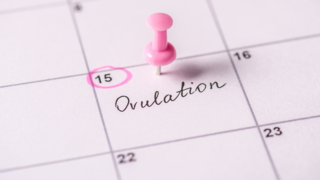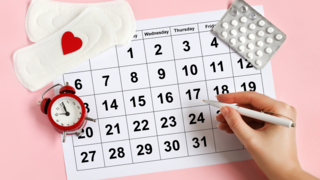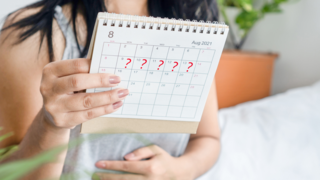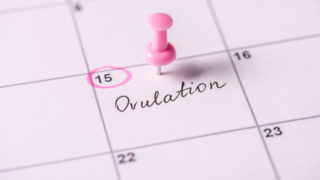
Ovulation

The egg then proceeds down the fallopian tube, where it may come in contact with a sperm and be fertilised.
The hypothalamus is a region of the brain that governs ovulation and hormone release throughout the menstrual cycle. The hypothalamus directs the anterior lobe and pituitary gland to release luteinizing hormone and follicle-stimulating hormone (FSH).
It is important to understand when ovulation is likely to occur since this is when conception is most likely to occur.
During the follicular phase, your body produces follicle-stimulating hormone (FSH), which helps the egg in your ovary develop and prepare for release.
When the egg reaches maturity, your body produces an increase in luteinizing hormone (LH), which causes the egg to be released. Ovulation typically occurs around day 14, 28 to 36 hours following an LH spike.
After ovulation, the luteal phase begins. If pregnancy develops at this time, hormones prevent the lining from shedding. If not, bleeding will start on or around day 28 of the cycle, indicating the start of the next one.
In short, ovulation often happens in the middle of the menstrual cycle.
Girls may begin menstruating as early as age 8, but the average is approximately 12 years. The average age at menopause (when periods cease) in this country is 51. Between the ages of 12 and 52, a woman will have around 480 periods, or less if she has pregnancies.
Progesterone, the hormone that helps the womb prepare for the implantation of a growing embryo, is produced in the latter part of the cycle.
The egg moves down the fallopian tubes. If pregnancy does not occur, the egg is reabsorbed by the body. Oestrogen and progesterone levels decline, and the uterine lining sheds and exits the body during a period.
The duration between the release of an egg and the commencement of a period is around 10 to 16 days.
After intercourse, the sperm may remain in the fallopian tubes for many days before fertilising the egg until it is ultimately released. The egg has around 24 hours in the fallopian tubes before it is no longer viable, meaning that it can no longer be fertilised.
Keeping track of the menstrual cycle may also help individuals detect anomalies. Instead, a person may choose to monitor their fertility using a pharmacy ovulation predictor kit. These may detect a rise in luteinizing hormone in urine just before ovulation.
On average, ovulation ceases at the age of 51, when menopause starts. Menstruation may become more irregular in the years before menopause. This time is known as perimenopause.
Ovulation is the process by which a developed egg is expelled from the ovaries. After it is released, the egg travels down the fallopian tube and remains there for 12 to 24 hours before being fertilised. Under ideal circumstances, sperm may survive in the female reproductive system for up to five days after sexual intercourse. When live sperm is present in the fallopian tubes during ovulation, your chances of becoming pregnant increase dramatically.
In an average 28-day menstrual cycle, ovulation happens around 14 days before the start of the next menstrual period. However, each person's cycle length is unique, and the time between ovulation and the start of the following menstrual period may change. If, like many individuals, you do not have a perfect 28-day menstrual cycle, maintaining a menstruation calendar will allow you to identify the duration and midpoint of your period.
Aside from the calendar, you may search for ovulation signs and symptoms, which include:
You may also want to try an over-the-counter ovulation kit, which may help you determine when you're most likely to ovulate. These tests test your urine for the hormone spike that occurs before ovulation. Ovulation happens around 36 hours following a positive result.
Ovulation is the process by which an egg is released from an ovary. Once an egg and sperm are fertilised, pregnancy occurs. The fertilised egg connects to the uterine lining.
Fertility refers to the probability of becoming pregnant. It might be useful to understand when in the menstrual cycle pregnancy is most probable. Depending on their preferences, a person may choose to have or avoid sex that might result in pregnancy at this period.
Pregnancy may occur anytime between 5 days before ovulation and 1 day after. This is due to the fact that sperm may survive in the vagina for up to 5 days, but eggs can only survive for roughly 24 hours after being expelled.
This ailment is also called mittelschmerz, which translates as "middle pain" in German. The pain generally comes every month. You'll feel it on the left or right side of your lower belly, depending on which ovary is producing an egg that month.
The discomfort might vary from minor to severe. It may feel achy or sharp, similar to a cramp. If the discomfort is severe, see a doctor. There may be methods for alleviating your suffering. A doctor may also evaluate if more testing or treatment is required.
In rare situations, discomfort during ovulation might indicate an underlying illness, such as:
Stress and food may influence the precise day of ovulation from month to month. Medical diseases such as polycystic ovarian syndrome (PCOS) or thyroid issues may cause ovulation to be erratic or halt entirely.
These disorders may produce various symptoms associated with changes in hormone levels, including:
Symptoms may include:
Even though the time of intercourse is important, concentrating too much on a schedule might cause stress, which affects fertility, therefore it's important to have fun during sex.
For this, you can:
The hypothalamus is a region of the brain that governs ovulation and hormone release throughout the menstrual cycle. The hypothalamus directs the anterior lobe and pituitary gland to release luteinizing hormone and follicle-stimulating hormone (FSH).
It is important to understand when ovulation is likely to occur since this is when conception is most likely to occur.
Ovulation and the Menstrual Cycle
How does ovulation fit into your total menstrual cycle?
Your menstrual cycle restarts on the day your menstrual flow begins. This marks the beginning of the follicular phase, in which the egg develops and is subsequently released during ovulation.During the follicular phase, your body produces follicle-stimulating hormone (FSH), which helps the egg in your ovary develop and prepare for release.
When the egg reaches maturity, your body produces an increase in luteinizing hormone (LH), which causes the egg to be released. Ovulation typically occurs around day 14, 28 to 36 hours following an LH spike.
After ovulation, the luteal phase begins. If pregnancy develops at this time, hormones prevent the lining from shedding. If not, bleeding will start on or around day 28 of the cycle, indicating the start of the next one.
In short, ovulation often happens in the middle of the menstrual cycle.
Understanding Your Menstrual Cycle
The menstrual cycle lasts from the first day of a woman's menstruation to the day before her next period.Girls may begin menstruating as early as age 8, but the average is approximately 12 years. The average age at menopause (when periods cease) in this country is 51. Between the ages of 12 and 52, a woman will have around 480 periods, or less if she has pregnancies.
What happens throughout the menstrual cycle?
Understanding the menstrual cycle requires knowledge of the reproductive organs located inside a woman's body. They are:- Two ovaries - where eggs are kept, matured, and released
- The womb (uterus) is where a fertilised egg implants and a baby grows
- The fallopian tubes are two small tubes that link the ovaries and the womb
- The cervix is the entrance to the womb from the vagina
- The vagina
Progesterone, the hormone that helps the womb prepare for the implantation of a growing embryo, is produced in the latter part of the cycle.
The egg moves down the fallopian tubes. If pregnancy does not occur, the egg is reabsorbed by the body. Oestrogen and progesterone levels decline, and the uterine lining sheds and exits the body during a period.
The duration between the release of an egg and the commencement of a period is around 10 to 16 days.
Phases of the Menstrual Cycle
The menstrual period averages 28 days. These may be broken into three stages:- The periovulatory, or follicular, phase: A layer of cells around the egg starts to grow and resembles mucus. The uterine lining starts to thicken.
- The ovulatory phase: This involves the egg and its network of cells leaving the ovary via an enzyme-created hole and entering the fallopian tube. This is also the phase of fertility, which typically lasts 24-48 hours.
- The postovulatory or luteal phase: This is when the body secretes luteinizing hormone. A fertilised egg implants in the uterus, but an unfertilised egg gradually stops releasing hormones and disappears after 24 hours.
The "Fertile Window"
The six days before and including ovulation are referred to as the "fertile window." This is the span of time during which sexual intercourse may result in pregnancy.After intercourse, the sperm may remain in the fallopian tubes for many days before fertilising the egg until it is ultimately released. The egg has around 24 hours in the fallopian tubes before it is no longer viable, meaning that it can no longer be fertilised.
Symptoms of Ovulation
Upcoming ovulation might result in increased vaginal discharge. The discharge is usually clear and elastic. Following ovulation, your discharge may decrease in volume and become thicker or cloudier.Ovulation might also cause:
- Minor bleeding or spotting
- Breast pain
- Increased sexual desire
- Ovary pain, defined as discomfort or pain on one side of the abdomen
When Does Ovulation Occur and How to Monitor It?
Ovulation often occurs around 10-16 days before menstruation begins. Tracking one's cycles allows some individuals to identify their peak fertility times. This is known as the ovulation calendar technique of forecasting fertility.The calendar approach includes multiple stages:
- Step 1: Monitor the menstrual cycle for 8-12 months. One cycle runs from the first day of one period to the first day of the following period. The typical cycle lasts 28 days, although it might be as little as 24 or as long as 38 days.
- Step 2:Deduct 18 from the number of days in the shortest menstrual cycle.
- Step 3: Deduct 11 from the number of days in the longest menstrual cycle.
- Step 4: On a calendar, note the beginning of the following period. Count forward using the number of days obtained in step 2. This is when peak fertility occurs. Peak fertility lasts the number of days estimated in step 3.
Keeping track of the menstrual cycle may also help individuals detect anomalies. Instead, a person may choose to monitor their fertility using a pharmacy ovulation predictor kit. These may detect a rise in luteinizing hormone in urine just before ovulation.
On average, ovulation ceases at the age of 51, when menopause starts. Menstruation may become more irregular in the years before menopause. This time is known as perimenopause.
Tracking ovulation
Understanding when you're ovulating and having intercourse frequently five days before and on the day of ovulation will increase your chances of conceiving.Ovulation is the process by which a developed egg is expelled from the ovaries. After it is released, the egg travels down the fallopian tube and remains there for 12 to 24 hours before being fertilised. Under ideal circumstances, sperm may survive in the female reproductive system for up to five days after sexual intercourse. When live sperm is present in the fallopian tubes during ovulation, your chances of becoming pregnant increase dramatically.
In an average 28-day menstrual cycle, ovulation happens around 14 days before the start of the next menstrual period. However, each person's cycle length is unique, and the time between ovulation and the start of the following menstrual period may change. If, like many individuals, you do not have a perfect 28-day menstrual cycle, maintaining a menstruation calendar will allow you to identify the duration and midpoint of your period.
Aside from the calendar, you may search for ovulation signs and symptoms, which include:
Change in vaginal secretions (cervical mucus)
Just before ovulation, you may notice an increase in clear, moist, and stretchy vaginal secretions. Cervical mucus reduces and thickens, becoming cloudier and less apparent shortly after ovulation.Basal body temperature varies
Ovulation causes a modest rise in your body's resting temperature (basal body temperature). Every morning, take your temperature using a thermometer built exclusively for measuring basal body temperature before getting out of bed. Keep track of the findings and look for any patterns that develop. You will be most productive in the two to three days before your temperature increases.You may also want to try an over-the-counter ovulation kit, which may help you determine when you're most likely to ovulate. These tests test your urine for the hormone spike that occurs before ovulation. Ovulation happens around 36 hours following a positive result.
Fertility vs Ovulation
Ovulation and fertility are closely related, although they are different.Ovulation is the process by which an egg is released from an ovary. Once an egg and sperm are fertilised, pregnancy occurs. The fertilised egg connects to the uterine lining.
Fertility refers to the probability of becoming pregnant. It might be useful to understand when in the menstrual cycle pregnancy is most probable. Depending on their preferences, a person may choose to have or avoid sex that might result in pregnancy at this period.
Pregnancy may occur anytime between 5 days before ovulation and 1 day after. This is due to the fact that sperm may survive in the vagina for up to 5 days, but eggs can only survive for roughly 24 hours after being expelled.
How to Test for Ovulation
At-home testing generally assesses hormone levels in urine, although a clinician may do both urine and blood tests.- Luteinizing hormone levels increase dramatically approximately 36 hours before ovulation, which may be detected with an at-home urine test
- Estrone-3-glucuronide, or E3G. E3G levels grow when oestrogen degrades. This occurs at around the same time as ovulation. A commercial urine test may evaluate both luteinizing hormone and E3G levels
- Progesterone. The uterus produces more progesterone during ovulation as it prepares for a fertilised egg. A blood test for progesterone at a clinic may confirm ovulation. There is also a commercial test for urine progesterone that may be labelled as "pregnanediol-3-glucuronide."
Ovulation Discomfort
It is quite typical to feel discomfort during ovulation. Up to 40% of individuals who ovulate experience pain during the middle of their menstrual cycle.This ailment is also called mittelschmerz, which translates as "middle pain" in German. The pain generally comes every month. You'll feel it on the left or right side of your lower belly, depending on which ovary is producing an egg that month.
The discomfort might vary from minor to severe. It may feel achy or sharp, similar to a cramp. If the discomfort is severe, see a doctor. There may be methods for alleviating your suffering. A doctor may also evaluate if more testing or treatment is required.
In rare situations, discomfort during ovulation might indicate an underlying illness, such as:
- Endometriosis
- Scar tissue in the abdomen
- Sexually transmitted infection (STI)
Irregular ovulation
If you monitor your ovulation from month to month, you may realise that you aren't ovulating on a regular basis or, in some situations, at all. This is a cause to consult with a physician.Stress and food may influence the precise day of ovulation from month to month. Medical diseases such as polycystic ovarian syndrome (PCOS) or thyroid issues may cause ovulation to be erratic or halt entirely.
These disorders may produce various symptoms associated with changes in hormone levels, including:
Symptoms may include:
- Increased growth of facial or body hair
- Acne
- Infertility, in some cases
When to Have Sex to Get Pregnant
According to research, having intercourse on a daily basis increases your chances of becoming pregnant by 37 per cent. A sexually active couple has a 25% probability of getting pregnant (when they do not have sex on a regular basis). Daily intercourse may be scientifically ideal, but it may not be humanly possible.Even though the time of intercourse is important, concentrating too much on a schedule might cause stress, which affects fertility, therefore it's important to have fun during sex.
Guidelines for Timing Intercourse
Here are some tips regarding when and how frequently to engage in sexual intercourse:- Having intercourse at least twice a week raises the chance of pregnancy
- Having intercourse just once a week reduces the probability of becoming pregnant by 15% compared to the average
- Long durations of abstinence may reduce the quality of a man's sperm, affecting male fertility
- The best moment for intercourse is immediately before a woman's ovulation; after ovulation, pregnancy is less likely to occur
- A woman should understand when she may ovulate, as indicated below: Having intercourse every day or two during a woman's mid-cycle provides the optimum possibility of conceiving
- The more you have sex, the more likely you are to have it at the peak reproductive window
Tests to Determine Whether You're Ovulating
You might ask your doctor for a medical test to ensure that you are ovulating. For example, a blood test for progesterone reveals that ovulation has occurred if a specified quantity of progesterone is present.Tablets and injections
If you are not ovulating on a regular basis, pills and injections may help enhance the hormones that regulate ovulation. To lower the risk of multiple pregnancies, the drug dosage must be carefully regulated.Increase your chances of ovulation
There are several strategies to increase your odds of ovulation.For this, you can:
- Eat regular, well-balanced meals to keep your weight in a healthy range
- Regular exercise is good, but don't do too much
- Use awareness or relaxing methods to control your worry/stress







